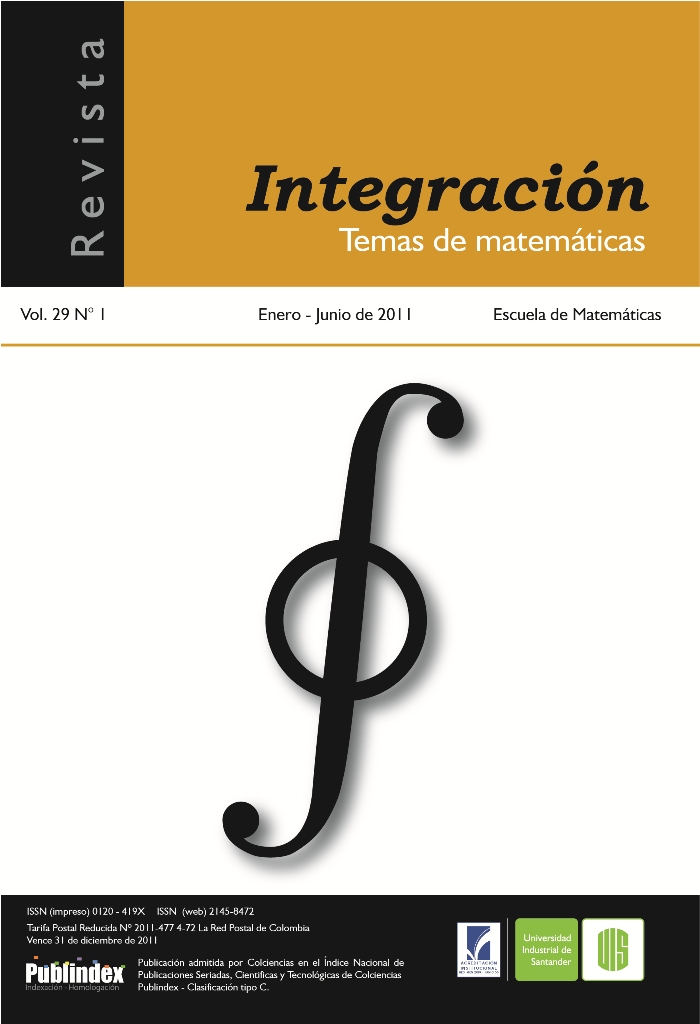Research and Innovation Articles
Published 2011-01-31
Keywords
- Produce a theorem,
- participation,
- rational behavior,
- provingactivity,
- Euclidean geometry
- university education ...More
How to Cite
Molina, Óscar M., Samper, C., Perry, P., & Camargo, L. (2011). Proving activity: participating in the production of a theorem. Revista Integración, Temas De matemáticas, 29(1), 73–96. Retrieved from https://revistas.uis.edu.co/index.php/revistaintegracion/article/view/2431
Abstract
We analyze the proving activity of three students of a university geometry course, when they were working collaboratively to solve aproblem. Underlying the solution process is the production of a theorem within a determined theory. With the purpose of describing the students’participation, the analysis concentrates in identifying and keeping track ofthe mathematical ideas that emerge and in identifying, in the students’ actions, the three aspects that, according to Habermas, characterize a rational behavior (teleological, epistemic and communicative). The findings permitus to affirm that undergraduate students can produce a theorem.
Downloads
Download data is not yet available.
References
[1] Mariotti M.A., “Proof and proving in mathematics education”, in Handbook of research on the psychology of mathematics education: Past, present and future (Eds. Gutiérrez A. y Boero P.), The Netherlands: Sense Publishers (2006).
[2] Mariotti M.A., Bartolini Bussi M.G., Boero P., Ferri F. and Garuti M.R., “Approaching geometry theorems in contexts: From history and epistemology to cognition”, in Proceedings of the 21st Conference of the International Group for the Psychology of Mathematics Education (Ed. Pehkonen, E.), Lahti, Finlandia: University of Helsinki (1997).
[3] Molina Ó., Samper C., Perry P., Camargo L. y Echeverry A., “Estudio del cuadrilátero de Saccheri como pretexto para la construcción de un sistema axiomático local”, UNION Rev. iberoamericana de educación matemática, 24 (2010), 117–134. Disponible en: http://www.fisem.org/web/union/revistas/24/ Union_024_012.pdf
[4] Moore R.C., “Making the transition to formal proof”, Educational Studies in Mathematics 27 (1994), 249–266.
[5] Morselli F. and Boero P., “Proving as a rational behaviour: Habermas’ construct of rationality as a comprehensive frame for research on the teaching and learning of proof”, in Proceedings of the Sixth Congress of the European Society for Research in Mathematics Education (Eds. Durand-Guerrier, V., Soury-Lavergne, S. y Arzarello, F.), Lyon, France: Institut National de Recherche Pédagogique (2009). Disponible en: http://www.inrp.fr/editions/editions-electroniques/cerme6/working-group-2
[6] Perry P., Samper C. y Camargo L., “Dos episodios que plasman rasgos de una comunidad de práctica en la que Cabri juega un papel clave”, Memorias del III Congreso Iberoamericano de Cabri, IberoCabri, (2006). Disponible en: http://funes.uniandes.edu.co/929/
[7] Selden J. and Selden A., “Understanding the proof construction process”, Proceedings of ICMI Study 19, Proof and Proving in mathematics education 2 (2009), 196–201.
[8] Sfard A., Aprendizaje de las matemáticas escolares desde un enfoque comunicacional. (Patricia Perry y Luisa Andrade, editoras de la traducción al castellano). Santiago de Cali, Colombia: Programa Editorial Universidad del Valle (2008).
[2] Mariotti M.A., Bartolini Bussi M.G., Boero P., Ferri F. and Garuti M.R., “Approaching geometry theorems in contexts: From history and epistemology to cognition”, in Proceedings of the 21st Conference of the International Group for the Psychology of Mathematics Education (Ed. Pehkonen, E.), Lahti, Finlandia: University of Helsinki (1997).
[3] Molina Ó., Samper C., Perry P., Camargo L. y Echeverry A., “Estudio del cuadrilátero de Saccheri como pretexto para la construcción de un sistema axiomático local”, UNION Rev. iberoamericana de educación matemática, 24 (2010), 117–134. Disponible en: http://www.fisem.org/web/union/revistas/24/ Union_024_012.pdf
[4] Moore R.C., “Making the transition to formal proof”, Educational Studies in Mathematics 27 (1994), 249–266.
[5] Morselli F. and Boero P., “Proving as a rational behaviour: Habermas’ construct of rationality as a comprehensive frame for research on the teaching and learning of proof”, in Proceedings of the Sixth Congress of the European Society for Research in Mathematics Education (Eds. Durand-Guerrier, V., Soury-Lavergne, S. y Arzarello, F.), Lyon, France: Institut National de Recherche Pédagogique (2009). Disponible en: http://www.inrp.fr/editions/editions-electroniques/cerme6/working-group-2
[6] Perry P., Samper C. y Camargo L., “Dos episodios que plasman rasgos de una comunidad de práctica en la que Cabri juega un papel clave”, Memorias del III Congreso Iberoamericano de Cabri, IberoCabri, (2006). Disponible en: http://funes.uniandes.edu.co/929/
[7] Selden J. and Selden A., “Understanding the proof construction process”, Proceedings of ICMI Study 19, Proof and Proving in mathematics education 2 (2009), 196–201.
[8] Sfard A., Aprendizaje de las matemáticas escolares desde un enfoque comunicacional. (Patricia Perry y Luisa Andrade, editoras de la traducción al castellano). Santiago de Cali, Colombia: Programa Editorial Universidad del Valle (2008).
